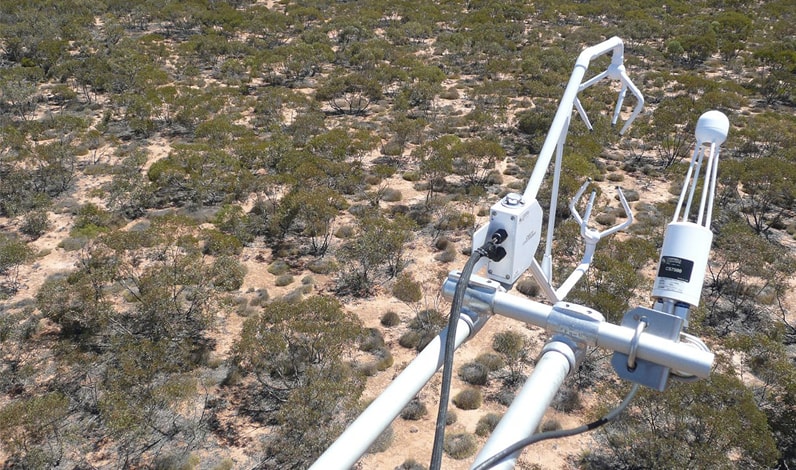This month’s site feature has us travelling into red dirt country again – to TERN’s Calperum Mallee SuperSite in the Riverland of South Australia. Over its 10-year lifetime, the site’s infrastructure has monitored ecosystem processes that shed light on how Australia’s widespread vegetation called Mallee is able to survive in such hot, dry, fire-prone conditions.
The Calperum Mallee SuperSite was established in 2010 with the overarching aim of measuring the fundamental carbon, water, energy and nutrient pools and fluxes in South Australia’s iconic Mallee ecosystems, including how these are likely to change with climate and management. The site is located within the Calperum Reserve that forms part of a 9,000 km2 Riverland Biosphere Reserve located on the Murray River floodplain.
Over its 10-year lifetime, the site’s infrastructure has monitored ecosystem processes that have shed light on how Mallee vegetation is able to survive in such hot and dry conditions. The tower-mounted sensors have contributed data to recent global ecosystem flux synthesis work and been used in several national and international ecosystem research efforts.
Data from the site are freely available through TERN, OzFlux and Fluxnet. The site is managed by Prof. Wayne Meyer at the University of Adelaide, and Dr Peter Cale of the Australian Landscape Trust.
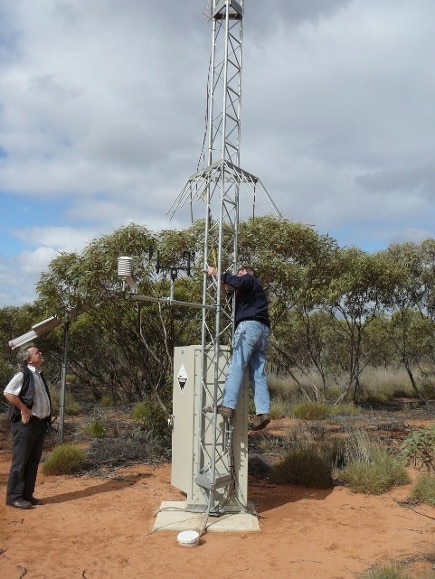
Top: the view from the top of the Calperum Mallee SuperSite’s eddy covariance tower overlooking the Mallee scrubland (credit: Wayne Meyer); above: Wayne Meyer assessing the instruments at the base of the tower (credit: Elena Kondrlova).
Data to understand rapid post-fire recovery
Like many of Australia’s ecosystems, Mallee vegetation is prone to burning. In January 2014, a large bushfire passed through the Calperum Mallee SuperSite destroying the ecosystem monitoring equipment, scorching the tree canopy, and consuming the spinifex grasses, litter and bark across the landscape.
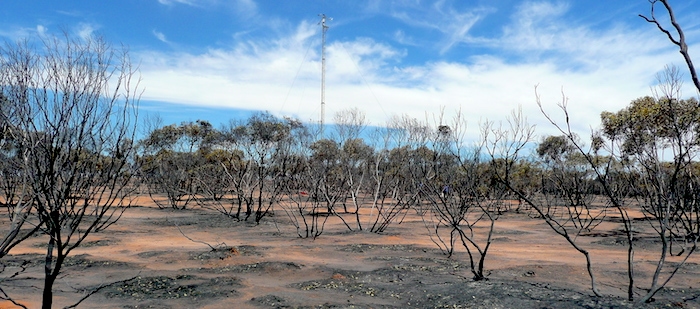
The Calperum site after the 2014 fire (credit: Wayne Meyer)
Whilst devastating for all involved, fires such as this are a normal and essential disturbance in the Mallee ecosystems in which the tower stands. With help from members in the TERN and OzFlux community, Wayne Meyer and the team were able to quickly re-install instrumentation to get the site up and running again, providing a great opportunity to study the recovery of the ecosystem.
“The mosaic effects of the fire on the vegetation, some untouched or partially burnt, and some completely wiped out, highlight how this ecosystem has evolved and survived. The OzFlux methodology, which spatially averages over a large area, is the only viable way of capturing this and measuring water and CO2 exchange in this type of ecosystem.
Despite the destruction and subsequent large sum of money and effort required to get things going again, the event offered up a great opportunity to augment the 3.5 years of excellent data collected so far and look at the effect of fire—one of the most important processes in carbon cycling—for an important Australian ecosystem that has evolved with such disturbance.”
Prof. Wayne Meyer, University of Adelaide
In the years following the 2014 bushfire, it soon became evident that the Mallee woodland vegetation was a specialist in recovery from fire.
A 2020 study using data from the site before and after the 2014 fire found that the ecosystem was a source of carbon for the first year and a half after the fire. Subsequently, the regrowth ensures that the ecosystem is again carbon accumulating while the degradation of the dead trunks will continue for at least the next 20 to 25 years.
While the fire had negative short-term effects on the site’s vegetation and ecosystem carbon balance, soil respiration remained less affected. Researchers found that soil fluxes were more strongly driven by water availability than the longer-term effects of fire.
“Fire in these Mallee systems is a rejuvenating event, primarily because the ecosystem has evolved to cope with its common but infrequent occurrence.”
Dr Peter Cale, Australian Landscape Trust

Timeseries of net ecosystem exchange (NEE) of carbon, gross primary productivity (GPP) and ecosystem respiration (ER) for the Calperum Mallee SuperSite (credit: Peter Isaac, using PyFluxPro). Note the drop in GPP after the Jan 2014 fire and periodic bursts of ER responding to rainfall events.
A history of climate extremes typifies Mallee ecosystems
Mean annual rainfall at the Calperum Mallee SuperSite is a meagre 252 mm, most of which falls in autumn and winter. However, over its 10 year measurement period, instruments on the site’s flux tower have recorded annual rainfall sums as low as 100 mm and as high as 500 mm, indicating the highly variable climate of the Mallee region.
The spring and summer months at the site are typically hot and dry, with a mean daily maximum of 25 degrees, says site manager Prof. Wayne Meyer.
“It’s often a long time between drinks for the Mallee vegetation that characterises the Calperum site.
Mallee vegetation at Calperum consists of four multi-stemmed Eucalyptus species – E. dumosa, E. incrassate, E. oleosa and E. socialis. Growing in patches between the sparse tree canopy are mainly spinifex, Acacia and Senna shrubs, and occasional ephemeral grasses.
These shrub and grass species have evolved to withstand periods of drought and extreme heat, and have an ability to rapidly respond to rainfall events when they arrive, which are often in high intensity, short duration events.
The ability to quickly increase productivity after rainfall events allows the Mallee vegetation to grow and maintain biomass – very much making the most of the times of plenty. The Mallee woodland species are certainly experts at surviving hot and dry conditions.”
Prof. Wayne Meyer, University of Adelaide
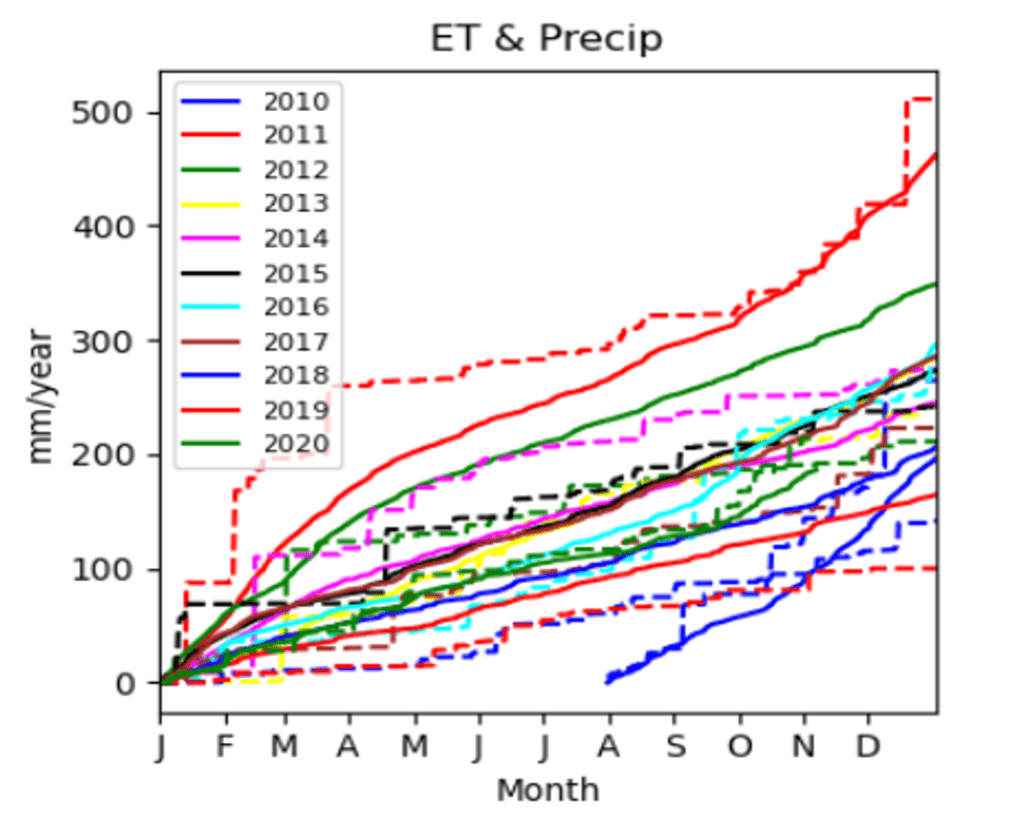
Cumulative annual rainfall and evapotranspiration (ET) recorded by the SuperSite’s flux tower over 10 years of measurement (credit: Peter Isaac, using PyFluxPro).
Measurement plans for the next decade
Continued monitoring and data collection at the Calperum Mallee SuperSite are at the top of the priority list for the next 10 years. With a growing long-term dataset, researchers will be able to address critical questions about how Mallee vegetation responds to decadal scale climate modes, such as the El Nino Southern Oscillation, Southern Annular Mode and Indian Ocean Dipole.
Further activities at the site will include quantifying the amount of water that the trees are obtaining from the deeper subsoil. These measurements will allow researchers to quantify how much water is coming from the deeper subsoil, and potentially from the regional groundwater, and the long-term consequences of this prolonged drying will need to be followed for a better understanding.
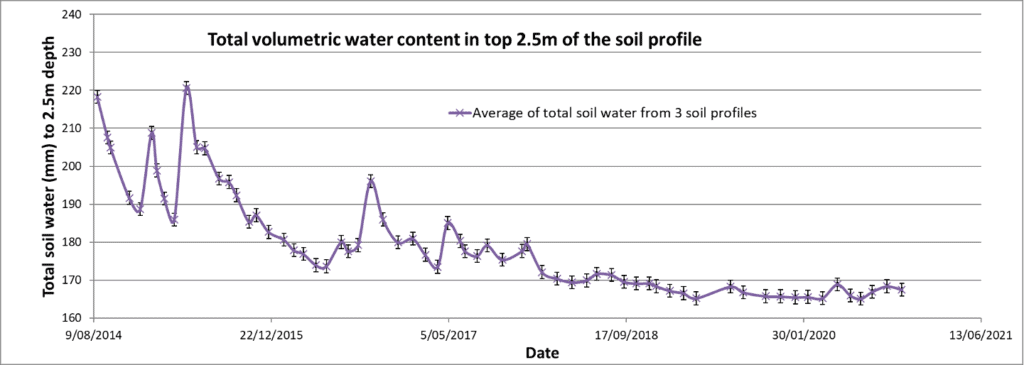
Soil volumetric water content at the Calperum Mallee SuperSite, illustrating that the top 2.5m of soil has essentially been dry since the end of 2017 and that there has been insufficient rain since then to actually rewet the upper profile (credit: Wayne Meyer).


